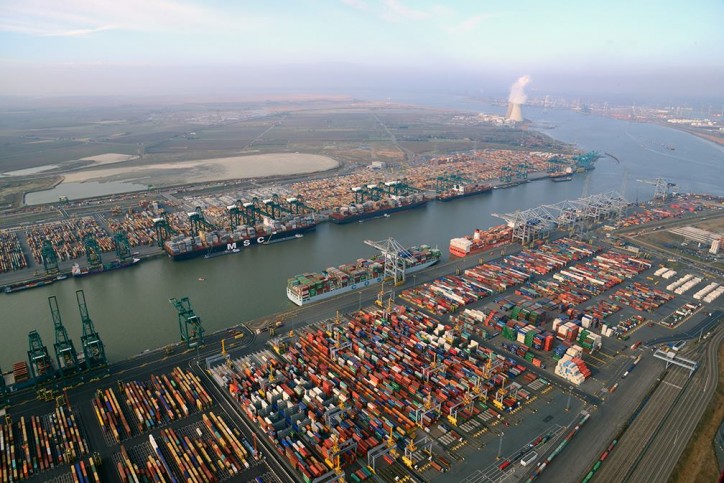After a record first three months the port of Antwerp has also had an excellent second quarter with May as the best month ever. During the first six months of the year the port handled 118,648,143 tonnes of freight, a sharp increase of 6.5% compared with the same period last year. The main driver continues to be container freight which experienced further rapid growth of 8.2% compared with the first six months of 2017.
Container volume continues to rise
The strong freight figures for the first quarter continued unabated in the second quarter. The container volume for its part rose by 8.2% to 66,298,043 tonnes. In TEU this indicates an increase to 5,567,905 TEU (up 8.3%). May was an all-time record month, with the port of Antwerp handling a peak container volume of more than 1 million TEU.

Growth was experienced on all trade routes, both on the import and on the export side. Despite geopolitical tensions there was a favourable economic climate with strong growth in consumer goods, wheeled vehicles and chemicals. Trade with Europe experienced the strongest growth, up 14.2%, thanks in part to Antwerp being able to win back transhipment freight which last year suffered a dip due to a temporary shortage of dock labour. Trade with North America for its part was up by 10.3%, although the first quarter of 2017 was fairly weak. On the Asian market there was growth of 3%.
"The strong performance of the port of Antwerp, our main economic engine, is good news for the Belgian economy in general," declared Port Authority CEO Jacques Vandermeiren. "The growth figures confirm our role as a leading world player and demonstrate the continuing attractiveness of the port. But they also confirm the previous forecasts that we will soon reach our maximum container capacity. During the past period we have well exceeded the optimum utilisation level for the terminals below the locks, which can have a negative impact on efficiency. We will therefore continue to emphasise the importance of having additional and commercially useful container capacity below the locks."
Port alderman Marc Van Peel added: "We appreciate the efforts of the Flemish government to arrive at a legally robust decision in favour of the complex project to build additional container capacity for our port. We now plead for a follow-up study of among other the nautical feasibility. Everybody stands to gain from a solution that will enable us to achieve the desired sustainable growth for our port. In this connection mobility is a constant concern for the Port Authority, to which it gives highest priority, and it goes without saying that we are prepared to take the right series of measures with all stakeholders. Creating additional commercially useful container capacity below the locks is a first step for us in the further development of the port."
Breakbulk
The number of cars shipped through Antwerp grew by 1.4%. Together with the 6.5% rise in the number of utility vehicles this resulted in a 5.2% growth in the total ro/ro volume, to 2,698,696 tonnes
Conventional breakbulk for its part got off to a good start at the beginning of the year but then declined as a consequence of lower imports of iron and steel. Compared with the same period last year the total volume fell by 6.5% to 5,045,235 tonnes.
The sharp drop of 8.5% in iron and steel imports in the first six months of 2018 is mainly due to the anti-dumping measures imposed on Chinese steel by the EU. Imports of steel from India too were well below the level of the same period last year.
Steel exports on the other hand present an opposite picture, with growth of 7.2%. In comparison with the same period in 2017 there was a strong upsurge in steel exports to the US in an effort to beat the American import tariffs which came into force in June.
However it is expected that these tariffs will also have an indirect negative effect on imports of iron and steel. Given the expected dumping of steel from all over the world on the European market as a consequence of the American tariff measures, the EU itself will probably be obliged to take measures to protect its own markets.
Liquid and dry bulk
Liquid bulk experienced very strong growth of 6.1%, to 38,296,955 tonnes. The main beneficiaries were chemicals (up 8.2%), but oil derivatives as the largest segment within this category also did well (up 6.4%) despite the slight drop of 3.6% in exports as a result of fluctuating oil prices.
Dry bulk for its part expanded by 3.1% compared with the same period in 2017. This was due mainly to the larger volume of fertilisers (up 14.4%) and sand and gravel (up 57%), as the other materials (coal, ore, kaolin and scrap metal) proved to be volatile over the past six months and are currently down.
Seagoing ships
A total of 7,210 seagoing ships called at the port of Antwerp during the past six months, up 1% on the same period last year. The gross tonnage of the ships arriving in port rose by 0.3%, taking the total to 207,963,909 GT.
Source: Port of Antwerp